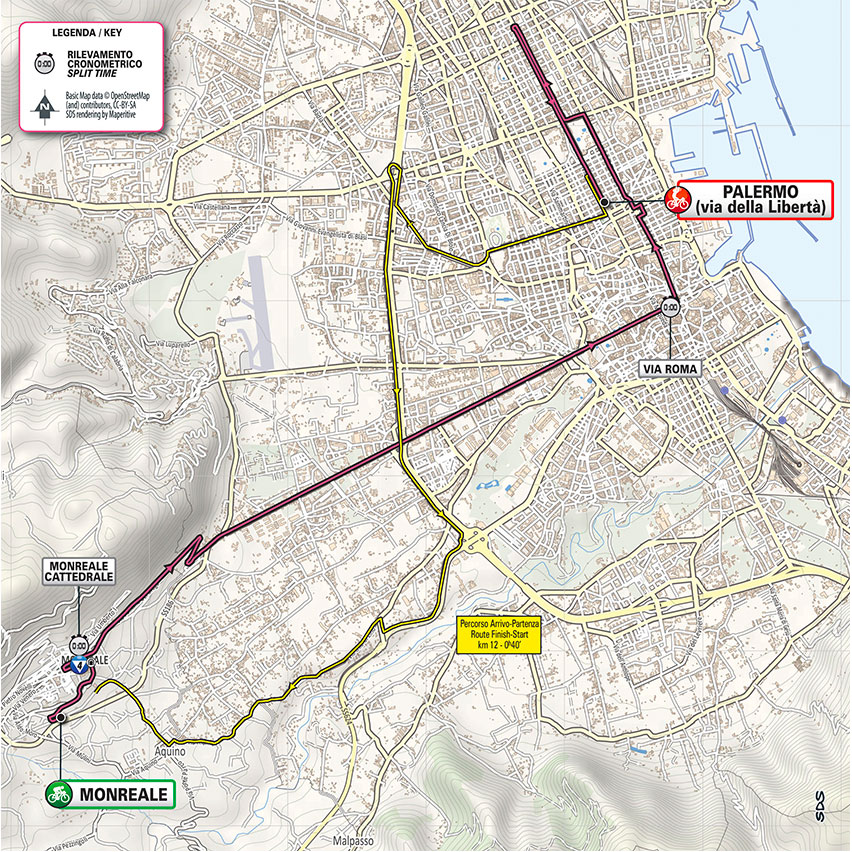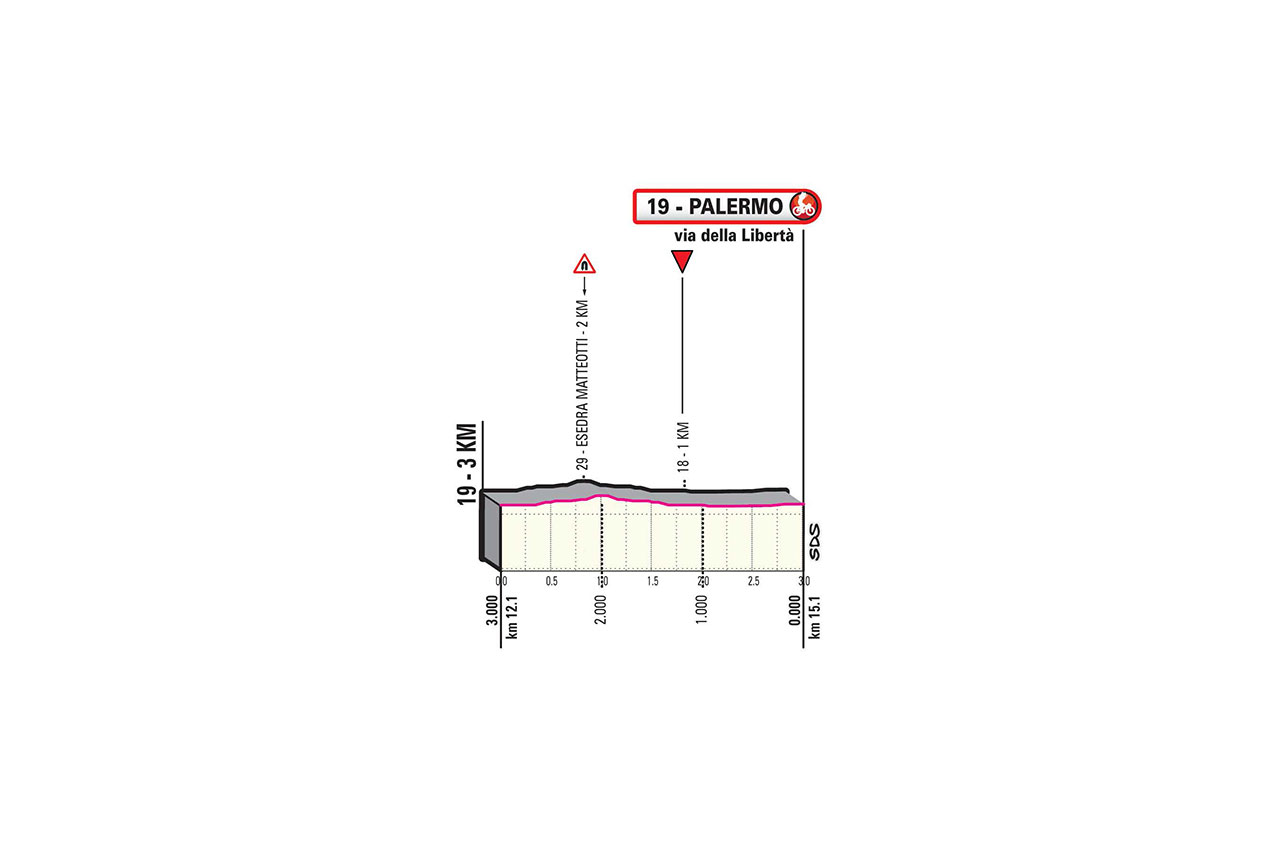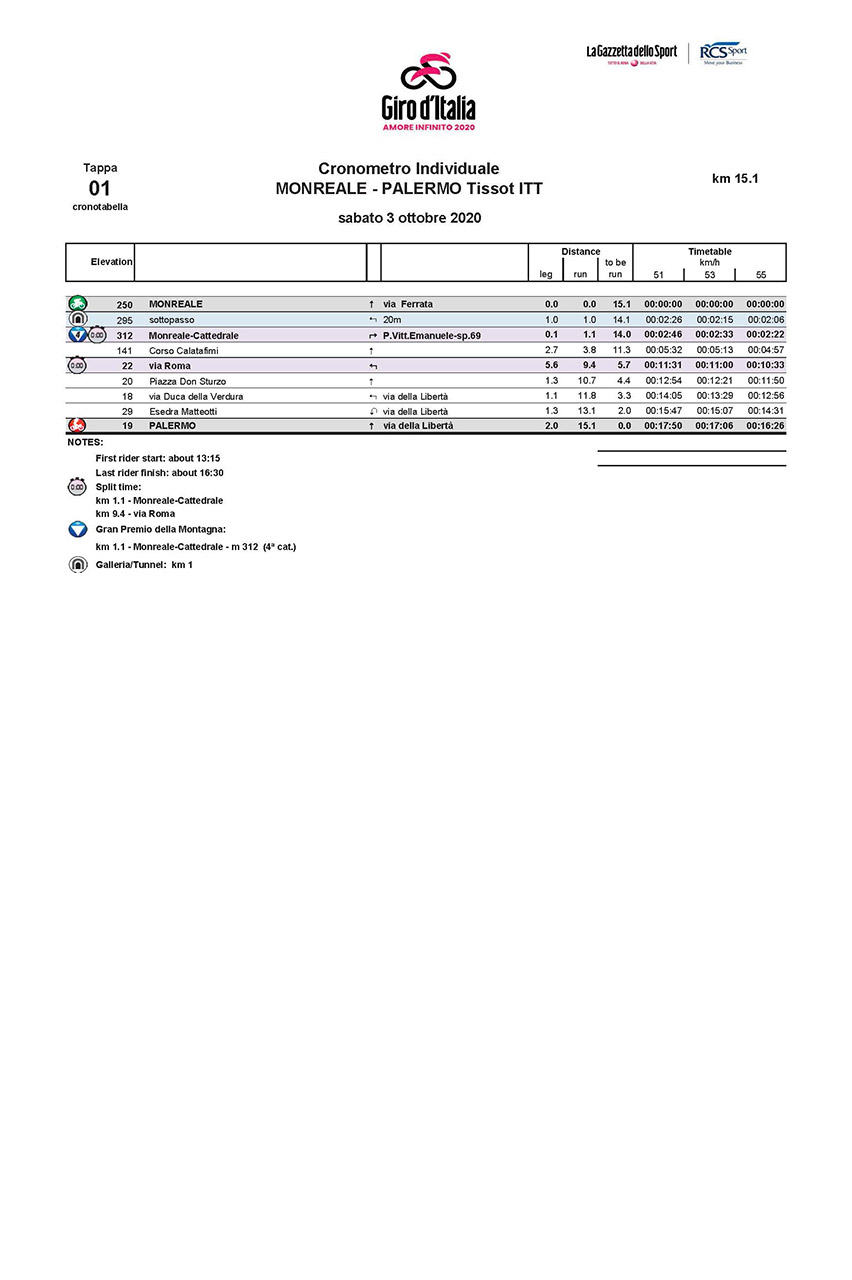profile
map
technical info
The Route
This ITT is played out entirely on city roads. Starting in Monreale, the route goes up, heading for the cathedral (running in an underpass/tunnel for 20 m), then takes a fast-running descent into the centre of Palermo. At the end of the descent, the route takes a left-hand turn (intermediate time recording); the second part of the stage features long straight stretches connected by wide bends. The route rises for 1 km and descends for three, so the profile is basically level, with some false-flat drags (sometimes going up, sometimes going down). The last 2,700 m run straight along Via della Libertà, all the way to the finish.
Final kilometres
The final kilometres run flat all the way to the finish line, which sits on 7 m wide tarmac.
start / finish
final kilometres
itinerary timetable
tourist info
Host city:
Monreale
Monreale is the twenty-first most populated city in Sicily and is part of the Metropolitan Area of Palermo. Only 8 km away from the capital, Monreale is the sixth municipality in Italy for the extension of its territory (529 km²); infact, the territory of Monreale entirely surrounds the municipality of San Giuseppe Jato and San Cipirello and, moreover, a smaller enclave is Ficuzza, a hamlet of Corleone.
Monreale has a very important historical peculiarity: it is a city, nowadays with 40,000 inhabitants, built around the immense and wonderful Norman Cathedral, built in 1174 by the king Guglielmo II. Furthermore, since 2015 Monreale is declared a “UNESCO World Heritage Site”, and it is part of the Arab-Norman route (that includes the Arab-Norman monuments of Palermo and the Cathedrals of Cefalù and Monreale).
Enriched with many ancient churches throughout the area, Monreale is famous for its numerous monuments such as: the Cloister of the Benedictines, the Guglielmo II ensemble, the various artistic fountains such as the “Fontana del Pescatore”, created by Marabitti and the “Fontana del Drago” whose marble puttos recalls the stucco works created by Giacomo Serpotta. The stucco works are also in the Church of San Castrense, patron saint of the town, in the “Palazzo di Città” and the in Benedictine Abbey of San Martino delle Scale.
The most traditional and characteristic activities of Monreale are the arts of mosaic and ceramics. Moreover, Monreale excels for its vineyards, orchards, olive groves and lush forests. Very famous is also the production of the wines: Insolia, Grillo, Catarratto, Nero d’Avola, Perricone, and the Extra Virgin Olive Oil DOP Val di Mazara. Other traditional product very famous and appreciated for its typical and delicious taste is Monreale bread; cooked strictly on wood, it is able to maintain an inimitable flavor and aroma, guarantee of goodness, and it has a very special fragrance and long shelf life. In the same ovens where the bread is baked, are cooked also the “S-shaped” Monreale biscuits and oblong biscuits filled with quince jam and candied cedar, brushed with frosted sugar invented by the nuns of San Castrense. Another very delicious typical product is the “sfincione”, mixed with ancient sicilian flours and seasoned with typical Cacio Cavallo cheese, tomato and onion.
A typical products of the land of Monreale are the “Sanacore” and “Ariddu di Core” plums, slow food presidium, that have a very sweet pulp and intense flavor and are preserved in thin paper braid by expert growers. Both varieties are very pleasant and together with citrus fruits they make up one of the delicacies of the area.
Among the most important events that characterize the culture and folklore of Monreale: the international festival of Holy music, the Feast of the Holy Crucifix, the “Infiorata” and the Monrealese Summer.
Food
OIL: DOP Val di Mazzara Extra Virgin Olive Oil
BREAD: it is a guarantee of goodness, fragrance and long shelf life. The indication Pane di Monreale, in addition to indicating a delicacy of the palate, is also a product that holds the primacy of taste, cooked strictly on wood, it is able to maintain an inimitable flavor and aroma.
S-COOKIES: in the same ovens where the bread is baked, the same “S” shaped biscuits and oblong biscuits filled with quince jam and candied cedar, brushed with glazed sugar invented by the nuns of San Castrenze are produced.
LO SFINCIONE: The sfincione, cooked rigorously in a wood oven, is of excellent taste and is mixed with ancient Sicilian flours and seasoned with typical Cacio Cavallo cheese, tomato and onion.
LE SUSINE : The Sanacore and Ariddu plums of Core sweet, whose dry flesh with an intense taste are preserved in thin paper braid by skilled growers, enter full-fledged slow food presidia. Both varieties are very delicate and together with citrus fruits they are na of the local delicacies.
Drink
THE VINE AND THE WINE: Insolia, Grillo, Catarratto, Nero D’Avola, Perricone
Points of interest
- Arabian-Norman Cathedral
- Chiostro dei Benedettini
- Guglielmo Complex II
- Artistic fountains of the monument Rocca-Monreale road
- Church of the Madonna delle Croci
- Piazza Vittorio Emanuele
- Piazza Guglielmo II
- City Palace
- Benedictine Abbey (San Martino delle Scale)
Palermo
Overview
Palermo is the capital of the autonomous region of Sicily.
The city is noted for its history, culture, architecture and gastronomy, playing an important role throughout much of its existence; it is over 2,700 years old.
Palermo is Sicily’s cultural, economic and tourism capital.
It is the main seat of the UNESCO World Heritage Site Arab-Norman Palermo and the Cathedral Churches of Cefalù and Monreale.
Food
- Caponata
- Pasta with sardines
- Anelletti Al Forno
- Sarde A Beccafico
- Babbaluci
- Panelle
- Spleen sandwich
- Sfincione
- Arancine
- Cannoli
- Cassata
Points of interest
- Palazzo dei Normanni
- San Cataldo’s Church
- Church of the Martorana
- Church of Saint Catherine
- Church of San Francesco d’Assisi
- Quattro Canti
- Piazza Pretoria
- Theatre Massimo
- Theatre Politeama
- Palermo Botanical Garden
Top video

Highlights Stage 1

Last KM

Filippo Ganna Interview
Photo gallery

















































































































